
文:林 菜穂子(baCe Inc.) 写真:Fumihiko Sugino アートワーク:Shun Sudo
text by Nahoko Hayashi(baCe, Inc.) photographs by Fumihiko Sugino artwork by Shun Sudo
この街を愛するすべての人々へ。ありがとう、そしてようこそブッシュウィックへ!
To all of you who love this town. Thank you, and welcome to Bushwick!
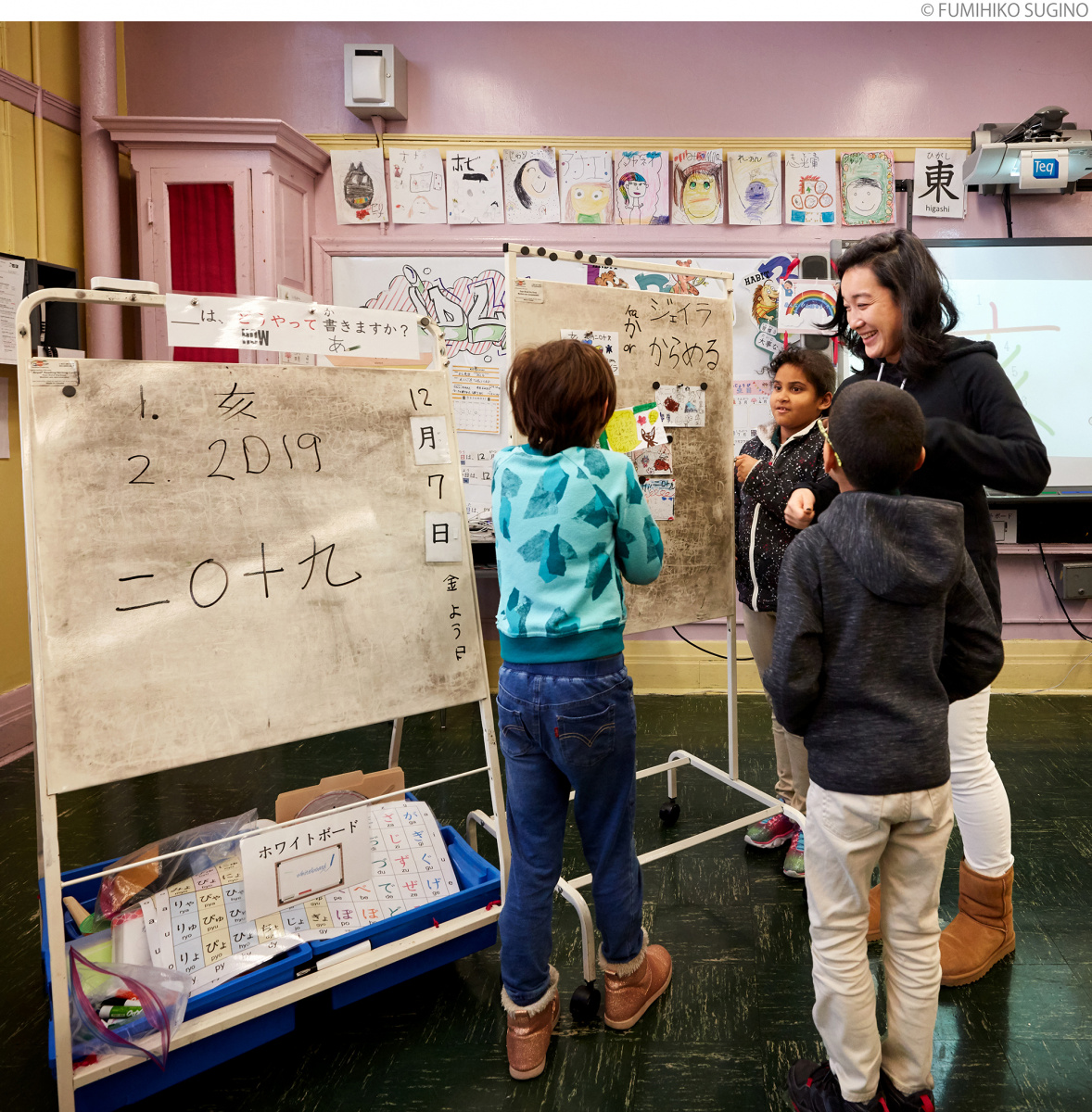
その日の午後、P.S.147の教室では担任の工藤先生(右)と一緒に生徒たちが来年の年賀状を書いていました。ホワイトボードには来年の干支「亥」の文字も!On the afternoon of that day, the children and their teacher, Kayo Kudo (right), were writing New Year greeting cards in a P.S.147 classroom. Next year is the Year of the Boar, and on the whiteboard was written the Japanese character for boar.
「亥」。「二〇十九」。
その日、ニューヨーク市立147校(Public School 147 Isaac Remsen:以下P.S.147)の小学2,3年生の合同クラスの生徒たちは、年賀状づくりに夢中になっていました。教室のホワイトボードには大きな文字で来年の干支「亥」と漢数字が書かれています。担任の工藤賀代先生が、
「コンテストがあるので、それに出品する年賀状を書いているんです」
と説明してくれるそのそばから、生徒たちは出来あがりの感想が聞きたくてどんどん声をかけてきます。ふと気がつくと、ひとりの女の子が私に近づいてきて、「私は寅年生まれなの」と言うのです。思わず、「わ、スゴイ!よく知っているわね」と驚いていると、それを横で聞いていたサンドラ・ノヨラ校長先生も興味津々で首をかしげています。
「では、私は何年生まれなのかしら?」
Boar. 2019.
On the day of my visit, the combined class of second and third graders at Public School 147 Isaac Remsen (P.S.147) were enthusiastically making New Year greeting cards. On the whiteboard in the classroom, in large Japanese characters were the word “boar,” for next year’s Year of the Boar, and numbers. Kayo Kudo, their teacher, explained that, “The children are writing New Year greeting cards for a contest.”
While she’s saying this, the kids come over eager to hear comments about the cards they made. Then one little girl came up to me and said, “I was born in the Year of the Tiger.” Astonished, I exclaimed, “Wow! I’m so surprised that you know that!” Hearing this, Principal Sandra Noyola tilted her head and mused, “I wonder what year I was born in.”
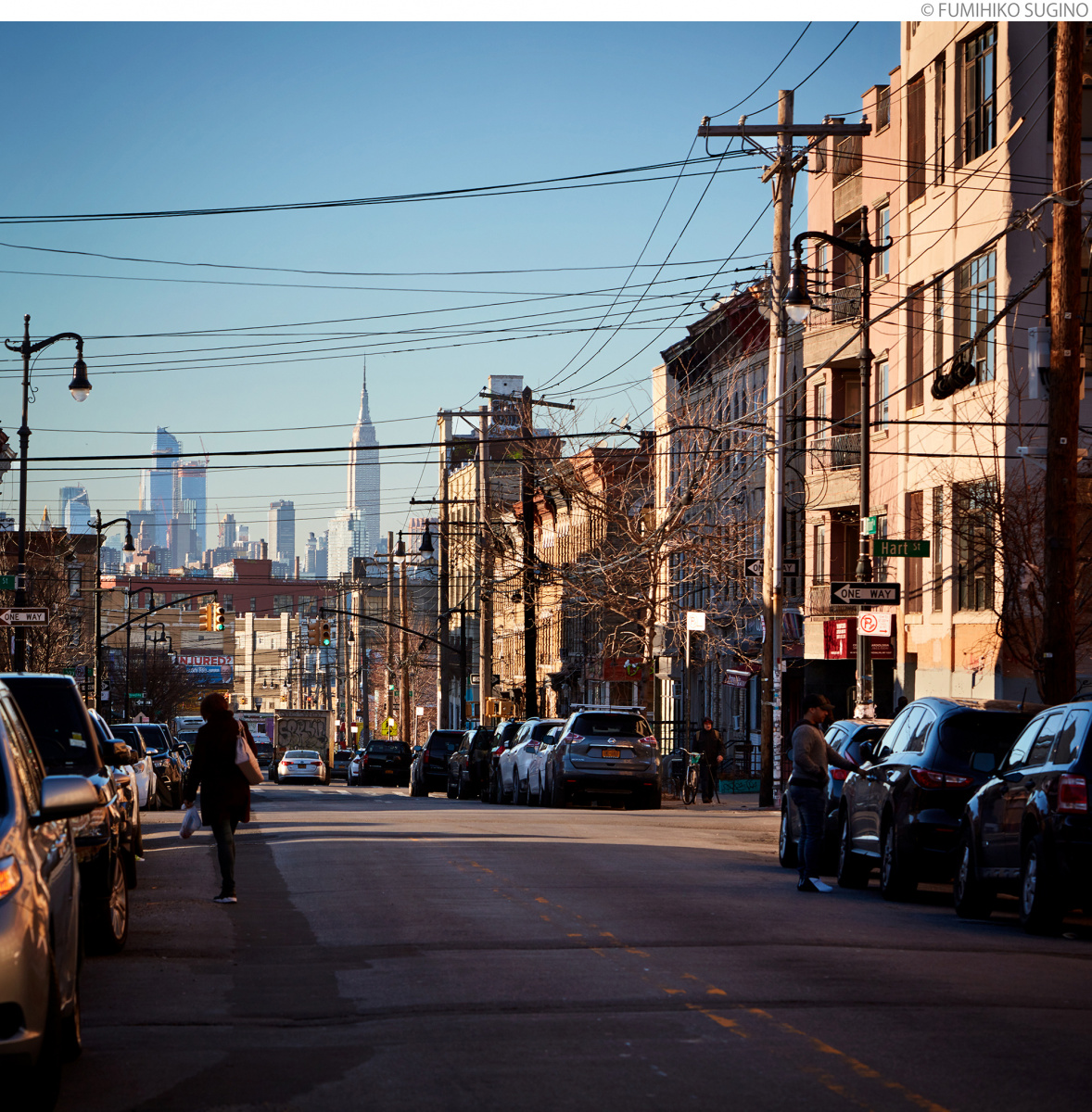
毎年「ブッシュウィック・オープン・スタジオ」でトラック・ギャラリーをしているこの通りからは、遠くにエンパイア・ステイト・ビルを見ることがでます。From this street where we hold a truck gallery during the annual Bushwick Open Studios, you can see the Empire State Building in the distance.
「最高に面白い街ブッシュウィック」の住人になりたての頃、私はあふれるアートにすっかり感化され、いつか仕事仲間と写真展や展覧会を開いてみたいと思うようになりました。だから「ブッシュウィック・オープン・スタジオ」を見つけたときは「これに参加しよう!」と嬉しくなったのですが、それも束の間、私たちには開けるべきスタジオがありません。そこでひねり出したのが、レンタルしたトラックの荷台に作品を載せ、人通りの多い場所に自ら出向くという苦肉の策。でも、これが数年後、素敵な出会いをもたらしてくれることをその時はまだ知る由もありませんでした。
Around the time I became a resident of “Bushwick, the most exciting neighborhood in New York,” I was totally inspired by all the art here, and wanted to someday hold a photo exhibition or show with the people I work with. So, I was overjoyed to learn about the Bushwick Open Studios event, and eager to participate. That joy was short-lived, however, because we didn’t have a studio to open. So, we racked our brains for a solution and came up with the idea of putting the works on the back of a truck and going to places where a lot of people gather. I didn’t have any idea at that time that this would lead to a wonderful meeting several years later.
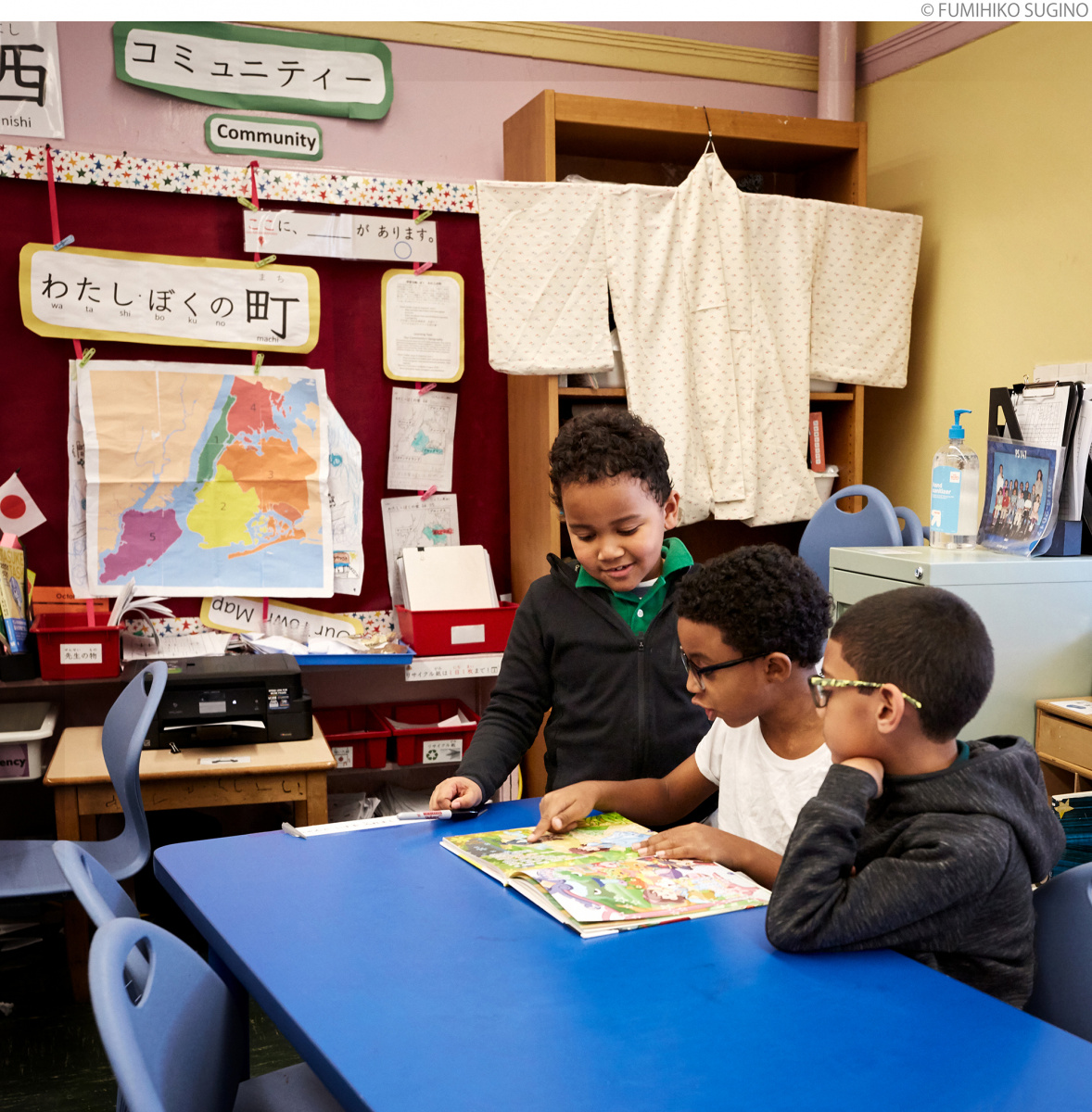
P.S.147の「日本語2カ国語プログラム」はニューヨーク初の、市内唯一のプログラム。対象は現在、幼稚園児から小学3年生までです。The Japanese Dual Language Program at P.S.147 is the first and only such program in New York City. Children from kindergarten to third graders can currently participate in this program.
さて、P.S.147は2015年にニューヨークの公立校として初めて「日本語2カ国語プログラム」を開始した、私のまわりの日本人のお母さんたちの間でもとても有名な学校です。
今年のブッシュウィック・オープン・スタジオで出会うことができたノヨラ校長先生が、その経緯を教えてくれました。
「ある親御さんたちのグループが、公立校で子供たちに日本語を教えて欲しいと訴えていたの。この学校に来る前にも、たくさん他校をまわっていたそうなのよ。その熱意は本当に素晴らしいものだった。でも、どこからもOKが出なかったから、私はそれに全力で応えようと思ったの」
いまもその親後さんたちと一緒にプログラムを進めていると言うノヨラ校長先生。聞けば、この街で生まれ、最も多感な時期を70、80年代のブッシュウィックで過ごしたと言います。
「この街は、本当に悪かったの。あの時のこともはっきり憶えているわ」
P.S.147 is very well known among the Japanese mothers around me as the first public school in New York to launch a Japanese dual language program in 2015. Principal Noyola, whom I had the fortune to meet through Bushwick Open Studios this year, informed me of the events leading up to the program’s establishment.
“A parents’ group had come requesting that Japanese be taught to children at a public school. They had apparently gone around to many other schools before coming to our school. I was impressed by their enthusiasm. And since they hadn’t been able to have their request accepted anywhere else, I decided to commit myself to making this happen.”
Principal Noyola, who says that the program is still being implemented with the help of these parents, was born and spent her most formative years in Bushwick in the 70s and 80s.
“This neighborhood was really terrible. I remember what happened back then very clearly.”
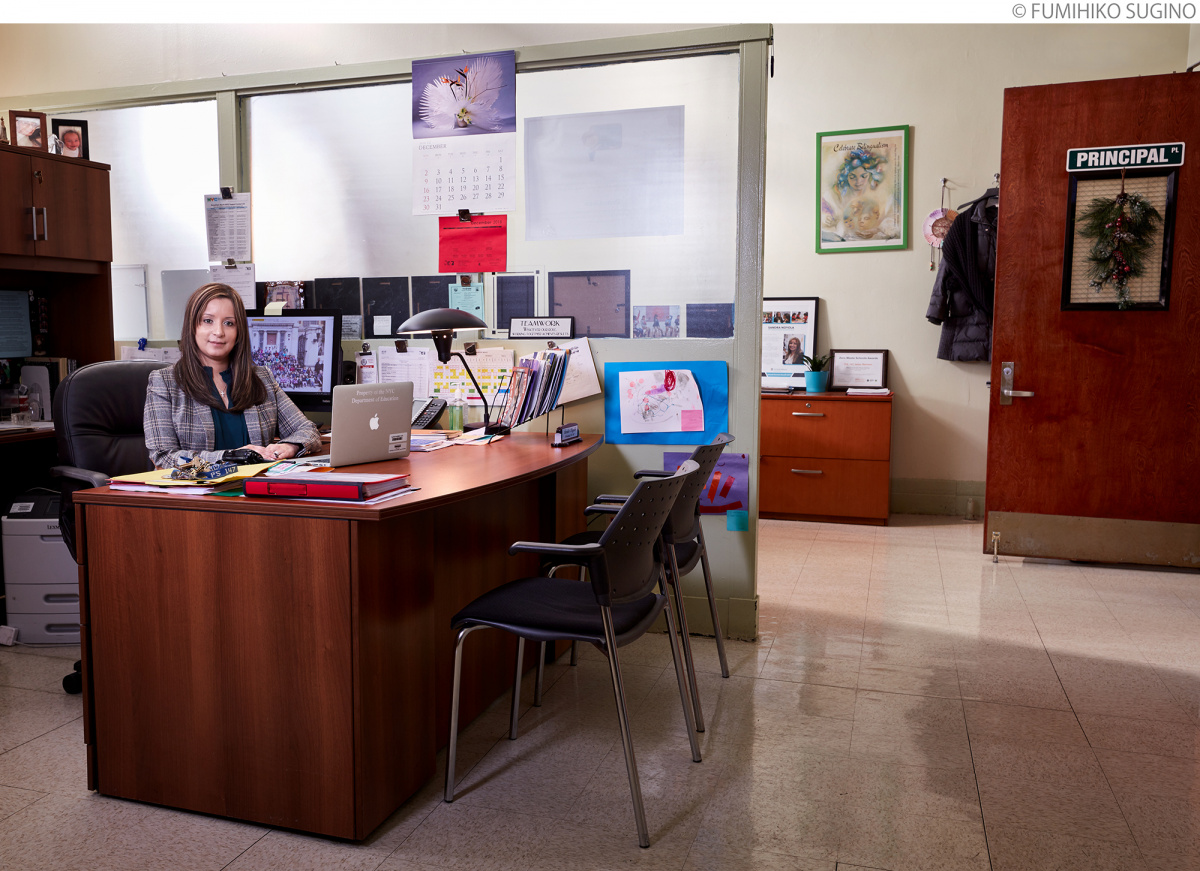
サンドラ・ノヨラ校長先生。赴任してまず取り組んだのは水栽培の実験室づくりでした。いま校舎の2階で野菜がすくすく育っています。Principal Sandra Noyola. The first thing she did after arriving at this school was to build a hydroponic lab. Vegetables are now being cultivated on the second floor of the school building.
あの時、1977年7月13日午後8時半過ぎ。
突如発生した停電は26時間に及んでニューヨークを大混乱に陥れ、ブッシュウィックとその周辺の街を戦場さながらの風景に一変させました。数日間に渡って暴動、略奪、放火が繰り返されたからです。この大停電は、当時、不景気などに喘いでいた人々の鬱憤を一気に爆発させる契機になったと言う人もいますが、80年代に入っても焼かれたビルや家屋の多くはそのまま放置されたそうです。
「そんななか、プエルトリコからの移民でシングルマザーの私の母は教育の大切を忘れなかった。母はスペイン語しか使えなかったから、私も小学1年まで英語を話せなかったのよ」
教職に就いて20年以上。様々な場所で仕事をしたノヨラ校長先生は8年前、P.S.147に着任しました。
「私にとってここに校長として戻って来たのはまるで奇跡。だからこそ教育者としてこの街に恩返しがしたいの」
“Back then” was July 13, 1977, a little past 8:30 p.m.
A sudden blackout that lasted for 26 hours plunged New York City into chaos, transforming the landscape of Bushwick and its surrounding neighborhoods into something resembling a war zone, with riots, looting, and arson occurring for several days. Some people say that this huge blackout provided a window for people already reeling from the poor economy to vent off their frustrations, but many of the razed buildings and homes were left as is even into the 80s. “In this kind of situation, my mother, a Puerto Rican immigrant and single mother, did not forget how important education is. Since my mother only spoke Spanish, I wasn’t able to speak English until I entered first grade.”
Principal Noyola, who became a teacher over two decades ago, held positions in many schools before coming to P.S.147 eight years ago. “For me, it was a miracle to come back here as principal. That’s why I want to give back to this community as an educator.”
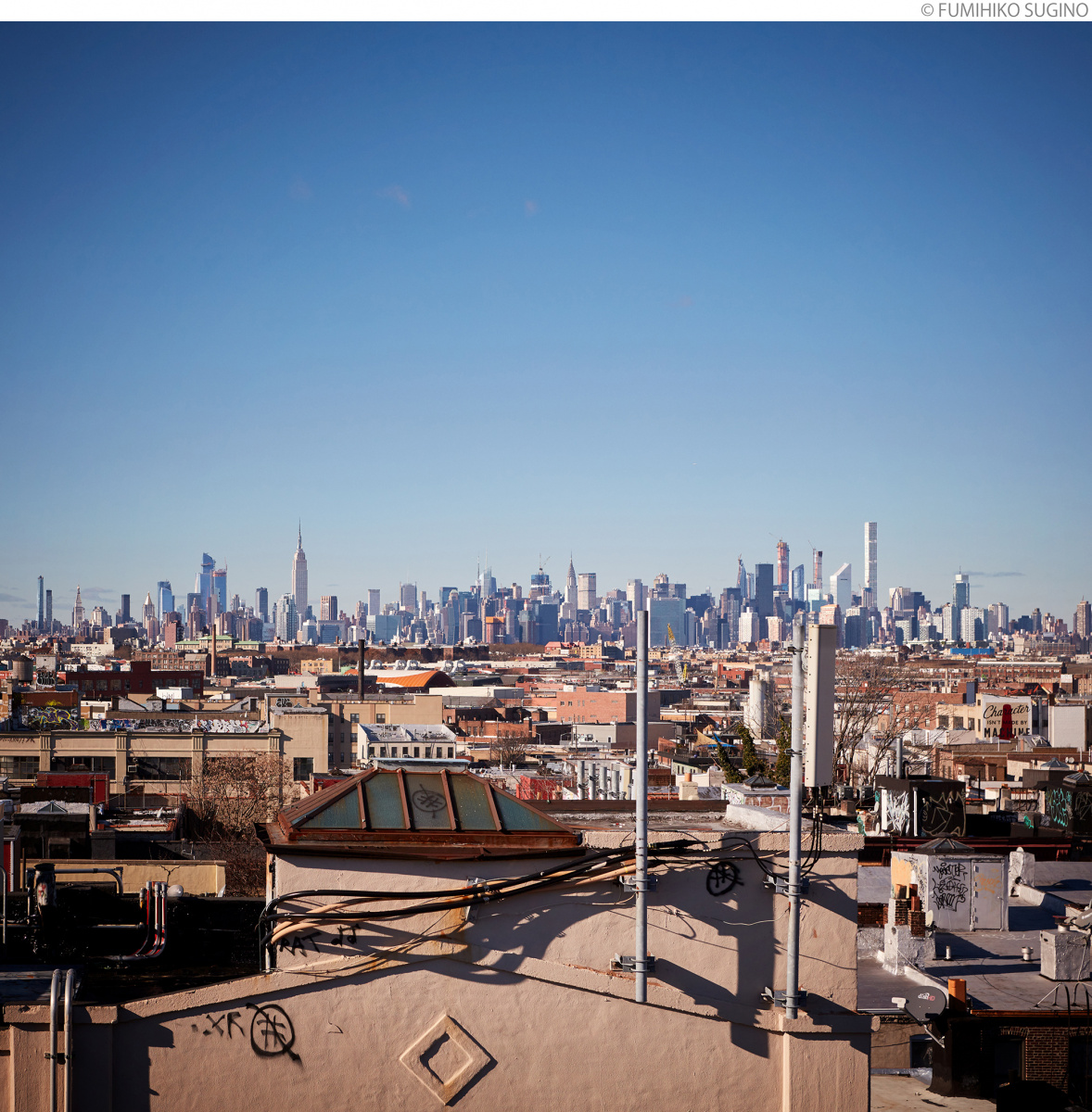
低層の建物が多いブッシュウィック。空は広く、マンハッタンの摩天楼も遠くに見渡せます。Many the buildings in Bushwick are low buildings, with an expansive sky spreading above. The skyscrapers of Manhattan can be seen far away.
「最高に面白い街ブッシュウィック」の住人になりたての頃、私はマンハッタンとは違うこの街の景色をかなり楽しんでいました。ひとつは360度見渡せる広い空。以前の自室からは、高層ビルに切り取られた不格好な四角い空しか見えなかったからです。
When I became a resident of Bushwick, the most exciting neighborhood in New York, I got a great deal of enjoyment out of the townscape, which was very different from that of Manhattan. One remarkable vista was the expansive, 360-degree view of the sky. From my old room in Manhattan, I was only able to see an awkward square of sky hemmed in by skyscrapers.
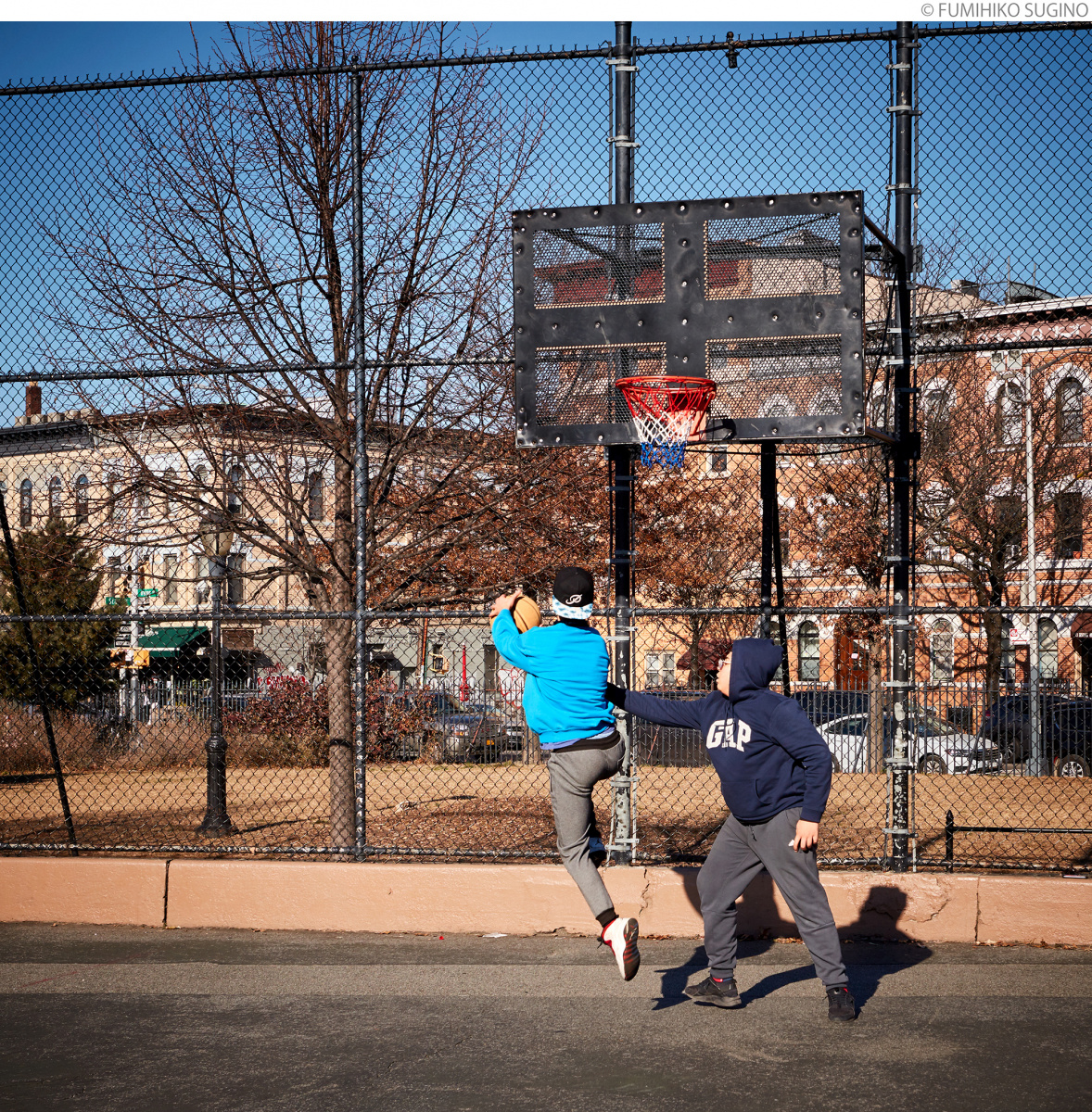
マリア・ヘルナンデス・パーク。ニューヨークの公園としてはごく普通に、バスケットボールなどの球技用コート、ドッグラン、子供たちのプレイグランドが整備されていて、夏の夕方ともなるとあちこちから大きな歓声が聞こえてきます。Maria Hernandez Park. Just like a typical New York park, it has courts for basketball and other ball sports, a dog run, and playground for children. On summer evenings you can hear loud cheers coming from all over the park.
近所の公園、マリア・ヘルナンデス・パークもそのひとつ。そこから聞こえる人々の歓声には懐かしさがありました。最近それを「雑音」「騒音」と捉える向きも多く、不自然なまでに声がしない公園をよく見かけていたからです。
Another endearing place is a nearby park, Maria Hernandez Park. There’s something nostalgic about the sounds of people you can hear coming from the park. That’s because there are now many parks that are unnaturally silent due to the recent trend for such noise to be considered as “irritating noise” or “noise pollution.”
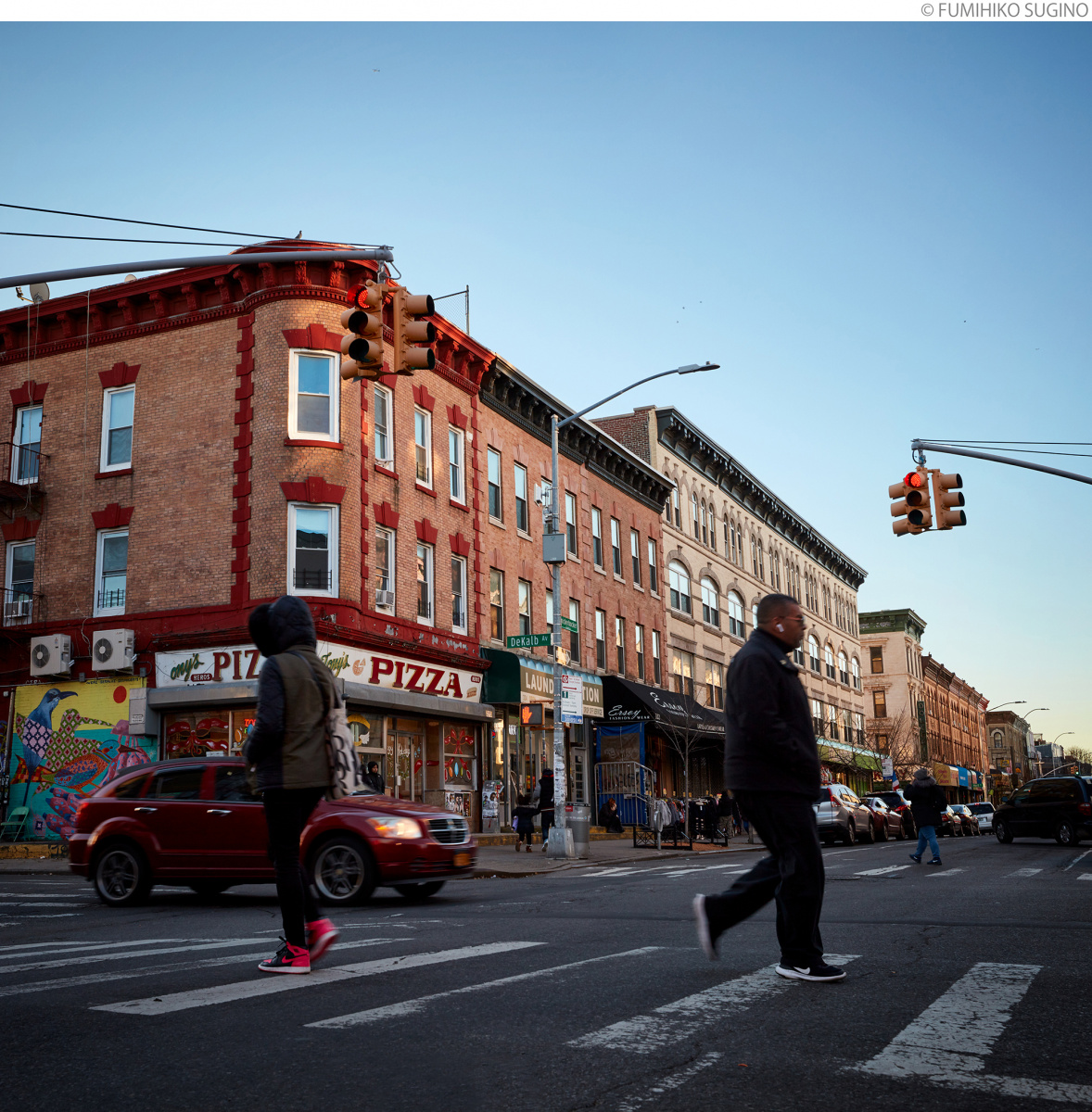
1969年から続くピザパーラーは、どこか懐かしいニッカボッカ・アベニュー商店街の象徴。ノヨラ校長先生は1977年の大停電のとき、お母さんとここで買い物をしていたそうです。
The pizza parlor established in 1969 is a symbol of the quaint Knickerbocker Avenue. Principal Noyola was here shopping with her mother at the time of the 1977 blackout.
古くからの面影を残すニッカボッカ・アベニューの商店街もこの公園に沿うように続いていて、いまでこそバーやカフェ、スポーツクラブなどが仲間入りしましたが、何でも安く手に入るこの商店街は、今も昔も庶民の強い味方です。
The commercial district of Knickerbocker Avenue, which exudes an air of the past, runs parallel to this park. Although it now has bars, cafes, sports clubs and other trendy facilities, this shopping street with its low prices has been, and is, a strong supporter of the general public.
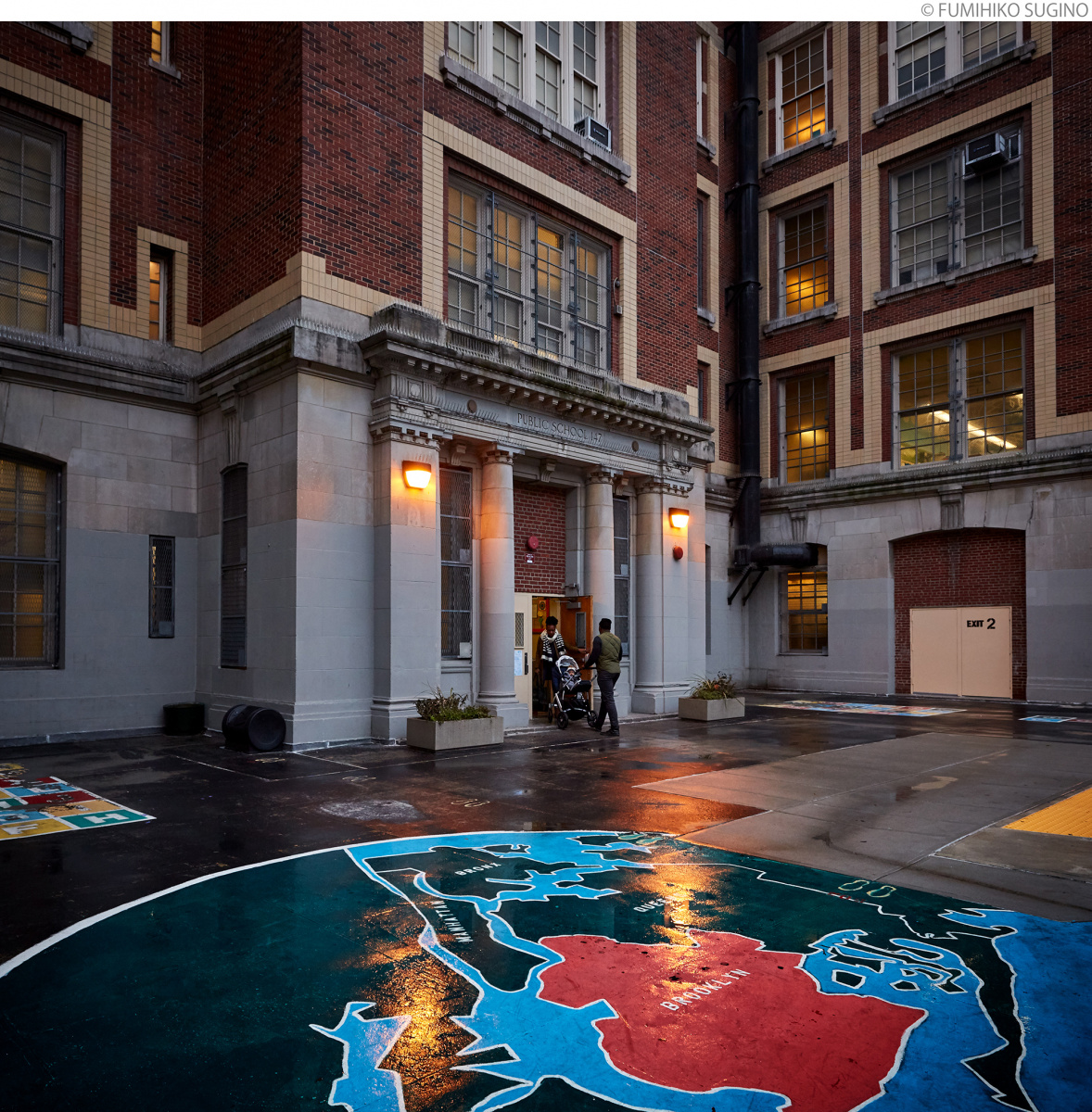
P.S.147の古くて立派な校舎。その入口に描かれた大きな地図が目を引きます。The stately old school building of P.S.147. The large map at its entrance is eye-catching.
「私は元々オープンな性格だけど、もっと他の人たちのことや彼らの文化を、言葉を知って、教育の幅を広げたいの。日本語を教えるのは日本人生徒のためだけではなく、それを知らない生徒たちにとてもいい影響を及ぼすから」
そんなノヨラ校長先生は、教育に関わる様々な分野の専門家や地域の人々との連携をいつも模索していると言います。
そして、ある日、なんと私たちのトラック・ギャラリーにも声をかけてくれたのです。
「だって、あなた方はこの街の素晴らしいコミュニティの一員でしょう。P.S.147へようこそ!」
ノヨラ校長先生の言葉は「ここではいつまでたっても外国人」とつい弱気になってしまう気持ちを俄然、前に向かせてくれました。「そうか、私たちは街の一員だったんだ」
“I am basically an open person, but I wish to broaden education through more knowledge about others, their culture, and language. We are not just teaching the Japanese language for the Japanese students, but because it has a very good influence on students who don’t know Japanese.”
Principal Noyola says that she is always searching for ways to team up with specialists in various realms related to education and the people of the community. And one day, she even approached us at our truck gallery, saying, “After all, you are wonderful members of this community. Welcome to P.S.147!” Though I tend to become faint-hearted that “I’ll always be a foreigner here,” these words by Principal Noyola immediately made me feel positive. “That’s right! We’re members of this community!”
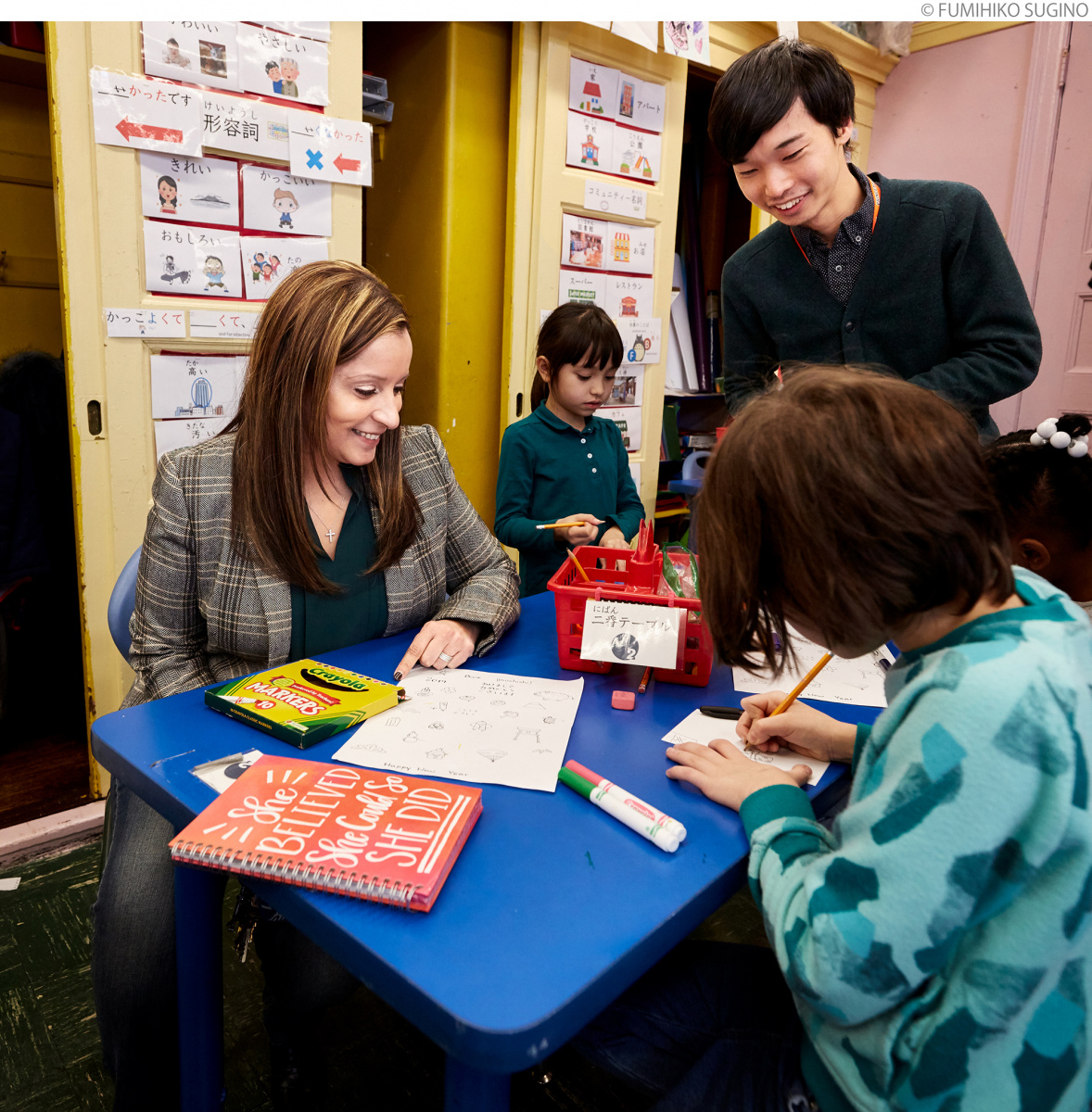
ノヨラ校長先生が教室に入ると生徒みんなの目がキラキラします。ヨシ先生(奥)はもう一人の日本人先生です。The children’s eyes shine when Principal Noyola enters the classroom. Yoshi (to the back) is the other Japanese teacher.
こんな、新しくて、古めかしいブッシュウィックには、まるでノヨラ校長先生のようにオープンで人なつこい魅力にあふれています。そして当たり前のことですが、この街の人々の暮らしは深く傷ついた過去の上に成り立っています。私たちのような移民も、新しい住人も、観光客も、わけ隔てなく受け入れるこの懐の深さは、悲しい経験を乗り越えてきたからこそ育まれたのだと思うのです。
Just like Principal Noyola, this new—and old—Bushwick is open and bursting with friendly appeal. And, it goes without saying that the lives of the people in this neighborhood are established on a deeply scarred past. I believe that the generosity they show in accepting us—the immigrants, new residents, and even tourists—was cultivated by overcoming sad experiences.
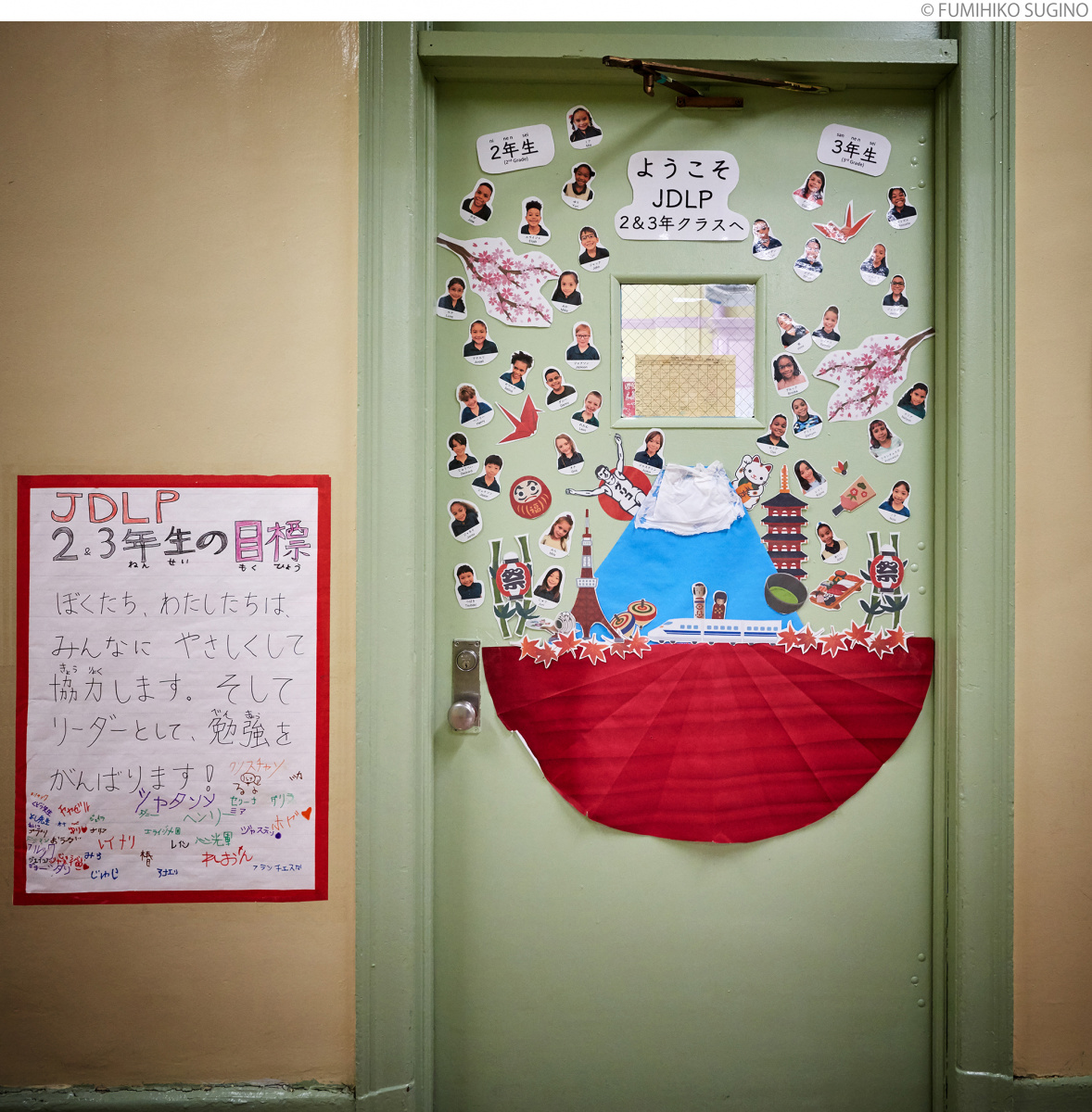
小学2、3年生の教室のドア。日本語で書かれたクラスの目標と「ようこそ」の文字が、この街で日本の文化が確実に育まれていることが伝えています。The door of the second- and third-graders classroom. The goals of the class and the word “welcome” written in Japanese send out the message that Japanese culture is being steadily cultivated in this neighborhood.
だから、きっとこの街はなにがあっても、前に、前に、たくましく進んで行くに違いありません。私としては、もしこの先、愛すべきこの街を離れることになったとしても「きっとまた戻って来る」と心から思える風景が、いまやっと見つかったように思います。
「ブッシュウィックへようこそ!」
ぜひまた。もしまだならば、いつかきっと。確かめに来て下さい。どんな風にこの街が、もっともっと、面白くなっているのかを。
That’s why I am sure that no matter what happens, this neighborhood will continue taking courageous steps forward. Even if I were to leave this beloved community in the future, I think I have finally found a milieu where I can truly say, “I will be back.”
“Welcome to Bushwick!”
Please come again. Or if you’ve never been here, be sure to visit sometime in the future. Please come and see for yourself how this neighborhood continues to become even more and more exciting.